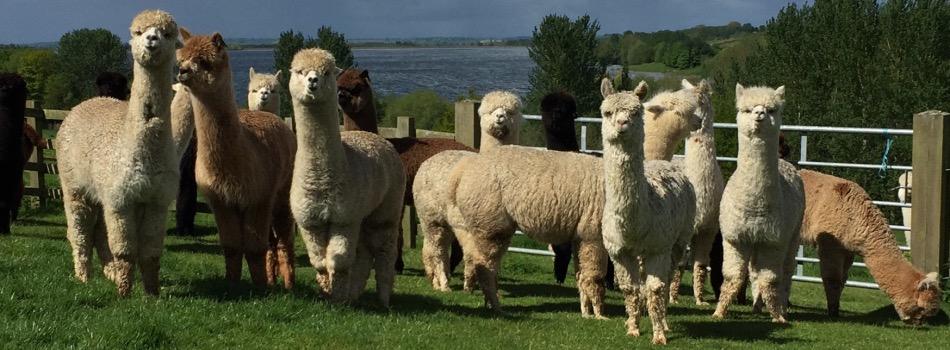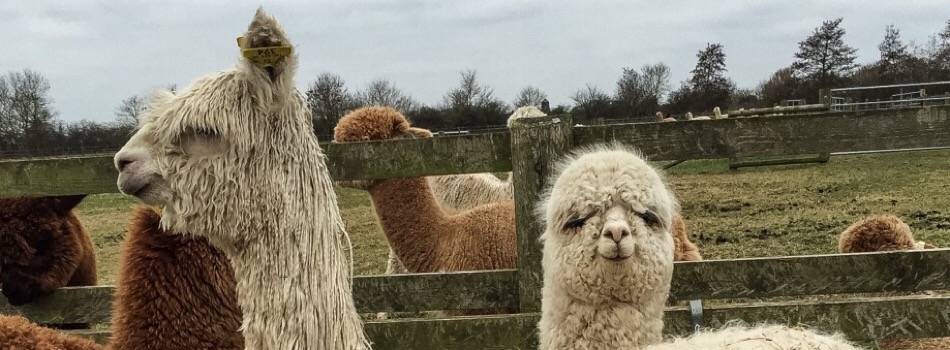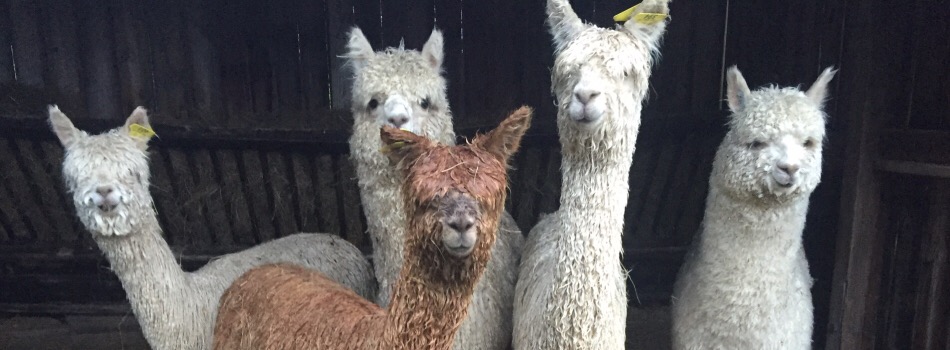TOFT & ACCOYO

When we first started breeding alpacas we had never kept any animal larger than a dog. To say we were as green as the grass in our paddocks would be a major understatement. We researched, read, we met, we talked and visited a lot of people, all of whom seemed to have different criteria for making their breeding decisions. At that time the only consistency in the theories expounded seemed to be that they all owned alpacas. The industry in the UK was in its infancy, indeed it still is today but then it really was a case of everyone being a enthusiastic novice and some would still say that nothing much has changed.
We duly bought alpacas that were considered the best available at the time; a brown, a black, a white and a fawn. We allocated the four different colours to our four children as it seemed a neat fit. Grant, our youngest son, names all the brown animals after characters from Star Wars, Scott names the whites after anything remotely connected with snow. Laura has the fawns which are named after spices and Kerry our eldest daughter names the black ones after anything that the alpaca reminds her of.
And so we set off paying our mating fees and breeding alpacas, carefully mating brown on brown, black on black etc. Although the births were exciting and the learning curve steep for all the family it soon became evident, through a number of surprise births, that we were engaged in a mating lottery. The genetic diversity of the alpaca caused by the unselected breeding in South America over the centuries seemed to have produced an animal which was truly capable of producing all the combinations of alpaca possible. Given that we were all working with imported animals at the time there was no such thing as pedigree, no colour consistency, no guarantee of the final outcome whatsoever. It seemed then that we could be on a random hit or miss situation for quite some time and should anyone ever produce a male that was colour consistent and bred true to type. Would we ever be able to afford the mating fees charged for such a wondrous animal?
Then we discovered Accoyo and saw a possible way forward. These animals were all white, because a premium is paid for white fibre in Peru. They bred true to type and were strong boned, tight framed, deep chested animals with clear exquisite heads who seemed to carry an enormous amount of quality fleece. I know one of the fascinations of alpacas is to see every colour imaginable wandering around the paddock, but to see a complete set of white animals that have a look that is definitive is like seeing the future. It felt controlled, it felt consistent and the fleece was truly a remarkable improvement which ran through all the animals in the herd.

In 1998 I was also fortunate to be working in Australia at the time of their National Show and there again the future was glimpsed as row upon row of consistently coloured alpacas trotted obediently into the ring one after the other. In most of the classes it was only the fleece quality that defined the winners.
You ask, you touch, you feel and the word Accoyo crops up again and again. A few farm visits, plenty of air miles and long afternoons talking alpaca in the Australian sun and you discover that 15 years after the alpaca industry in Australia had emerged as a going concern the top stud animals were still the big six. The legend had it that six Accoyo animals were virtually "smuggled" out of Peru and their genetics and offspring have formed the wellspring of the improvement in the Australian alpaca. Of course more excellent genetics had been added since, but it seemed to a man who was lost in the randomness of the British herd that Accoyo was shining like the holy grail. I was lucky enough to get hands on with a couple of these males and I have to say the fleece was exceptional even then and they were nearly twelve years old at the time.
A return to England and the mating policy for TOFT alpacas was soon established. At last I had seen some of the best alpacas in the world and had a standard, a marker to work from and to. We started to purchase white animals that echoed the Accoyo look and bred to the available Accoyo males. We took a risk on a young pure Accoyo male that came available and worried as he matured over the next 18 months whether our investment would take us where we wanted to go.
In the meantime Shirley and I attended the Alpaca Fiesta in Arequipa in Peru. Another revelation and anyone who wants to understand these animals and how to breed them would be well advised to visit their homeland and see what it is they are taking on. The 'grazing' is a revelation in itself and a total contrast to what we understand as sparse but the breeding programs started to give a real perspective on the imported animals in our UK herd. Apart from certain herds which are bred with a degree of control the mixed genetics of the numerous small herds wandering the alti-plano look like they've been put together by police identikit. The mix of llama, Suri, Huacaya and Vicuna was self evident in many of the animals we saw. The true to type alpaca of excellence as exhibited in the show ring in Arequipa started to seem like a very rare alpaca indeed. Only one disappointment in what was a truly revelatory trip; the Accoyo animals were not exhibiting that year. The animals I had come to see were 1000 miles away in a place called Macusani which unfortunately wasn't on our schedule. Oh well… one day.
That day came a lot sooner than expected when the following year I was invited to Peru to purchase animals on a pre-selection for a proposed import by the Hamilton group. The highlight of the trip, apart from selecting the finest brown boy in the herd to come to TOFT Alpacas to service our coloured animals, was a trip to meet Don Julio Barreda and the Accoyo herd at Macusani. The only problem was that we arrived late (a long story), but even in the short time I was there the Accoyo herd was truly impressive. To see 1000 animals, all white, all bearing the hallmarks of sixty years of Don Julio's stewardship and selection, was indeed to glimpse the future.
I have no doubt at all that we did not see the best animals in the Accoyo herd but what we did see was a standard of excellence that is probably unparalleled in any alpaca herd in South America if not the world. Don Julio has been a pioneer in the improvement of the alpaca in Peru and his life's work stands all around him in the paddock. When you read about Accoyo and where he began the achievement only becomes more and more remarkable. Don Julio Barreda has worked a lifetime in improving white alpacas and the results have to be seen to be believed. It is a fantastic sight to be on his farm in Macusani and see two thousand, all white, beautifully conformed, dense animals with some of the finest fleeces in the world. Only then do you begin to feel that the dream of breeding excellence in alpacas is no longer just a dream but is indeed an achievable goal.
At TOFT Alpacas we decided to give ourselves a jump-start in the search for consistency by breeding our females into the sixty years of selection already pioneered by the Accoyo herd. The results so far have been very rewarding; our pure Accoyo male Cornelius came up trumps in his first season and set a standard to work for in our future breeding decisions. Don Julio is one of the most respected breeders of alpacas in Peru and his animals have formed the foundation stock of many of the herds of excellence in South America and across the world. He has devoted his life to the improvement of the alpaca and we can think of no better starting point than breeding the world famous Accoyo genetics into our herd.
